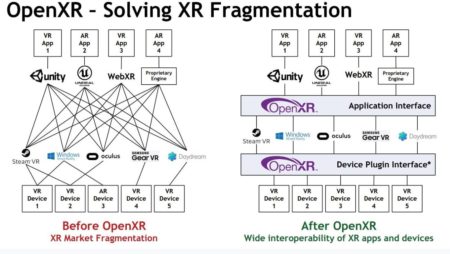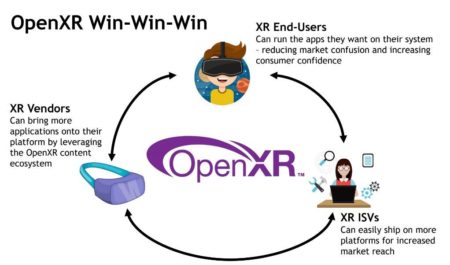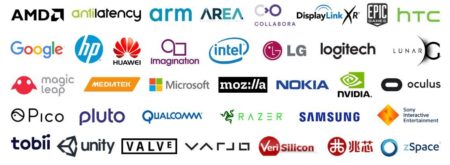SIGGRAPH 2019 begins today in Los Angeles and The Khronos® Group, an open consortium of leading hardware and software companies creating advanced acceleration standards, announces the ratification and public release of the OpenXR™ 1.0 specification together with publicly available implementations and substantial ecosystem momentum. OpenXR is a unifying, royalty-free, open standard that provides high-performance, cross-platform access to virtual reality (VR) and augmented reality (AR)— collectively known as XR—platforms and devices. The new specification can be found on the Khronos website and via GitHub.
OpenXR 1.0 Specification
“The working group is excited to launch the 1.0 version of the OpenXR specification, and the feedback from the community on the provisional specification released in March has been invaluable to getting us to this significant milestone,” said Brent Insko, OpenXR working group chair and lead XR architect at Intel. “Our work continues as we now finalize a comprehensive test suite, integrate key game engine support, and plan the next set of features to evolve a truly vibrant, cross-platform standard for XR platforms and devices. Now is the time for software developers to start putting OpenXR to work.”

The Khronos Group’s OpenXR will help solve a critical fragmentation problem within the larger AR/VR/MR industry.
After gathering feedback from the XR community during the public review of the provisional specification, improvements were made to the OpenXR input subsystem, game engine editor support, and loader. With this 1.0 release, the working group will evolve the standard while maintaining full backward compatibility from this point onward, giving software developers and hardware vendors a solid foundation upon which to deliver incredible, portable user experiences.
Together with this release, the OpenXR standard is receiving continued ecosystem support from Khronos member companies. OpenXR implementations from members are shipping this week, including the ‘Monado’ OpenXR open-source implementation from Collabora, the OpenXR runtime for Windows Mixed Reality headsets from Microsoft, as well as an OpenXR implementation from Oculus. Epic Games plans to release OpenXR 1.0 support in Unreal Engine with this specification ratification.
Congratulations to the OpenXR team on this important 1.0 release. The flexible, extensible design of OpenXR 1.0 will support innovative, next-generation graphics technologies that accelerate XR applications and even enable new XR use-cases.
At SIGGRAPH 2019, OpenXR members, Epic Games, Microsoft, and Varjo will demonstrate cross-platform XR applications within the same OpenXR API, showing how OpenXR 1.0 helps to reduce industry fragmentation. The demonstrations will take place during the OpenXR Birds of a Feather (BOF) presentation at 1:00 p.m. on July 31.
Broad AR/VR Industry Support for OpenXR 1.0 Spec
The broader AR and VR industry has embraced the work by The Khronos Group and its OpenXR specification standards-setting. Companies like AMD, ARM, Epic and Varjo and others fully support the purposes and mission behind the new standard.
“OpenXR 1.0 release is a huge milestone and AMD is proud to have been a member in its creation. The expanding XR industry and ecosystem continues to be a key focus for AMD and we are excited by the potential for market growth that OpenXR 1.0 enables. As always, AMD is a proponent of open industry standards,” said Daryl Sartain, Director of XR at AMD.
“Arm is focused on developing technology innovations that power the next generation of untethered, standalone AR/VR devices. The release of the OpenXR 1.0 specification will further enable us to break barriers for cross-platform XR applications while bringing the performance and efficiency required to support these complex, immersive use cases,” said Roger Barker, director of IP solutions, Immersive Experience Group, Arm.
We’re thrilled to support the OpenXR 1.0 release, along with all of the Khronos Group members who have worked tirelessly to create the standard. Unreal Engine led the way with support for the OpenXR 0.9 provisional specification, and we’re excited to move the 1.0 revision forward in collaboration with our hardware partners releasing at the same time. Epic believes that open standards are essential to driving technology and bridging the gaps between digital ecosystems,” said Jules Blok, Epic Games.
“WebXR relies on APIs like OpenXR to provide the communication layer between browsers and virtual reality or augmented reality devices. The Immersive Web Working Group is excited for OpenXR support to become widely available because it has the potential to reduce the development and maintenance burden for WebXR implementers while increasing the range of supported hardware,” said Brandon Jones, WebXR Spec Editor, Google.
“Congratulations to the OpenXR team on this important 1.0 release. The flexible, extensible design of OpenXR 1.0 will support innovative, next-generation graphics technologies that accelerate XR applications and even enable new XR use-cases,” said David Weinstein, Director of Virtual Reality at NVIDIA.
“Varjo is creating the world’s most groundbreaking VR/AR/XR hardware and software by merging the real and digital worlds seamlessly together in human-eye resolution. We’re excited for the release of the OpenXR 1.0 specification because it ensures the enterprise community has compatible, easy access to the best XR technology on the market today while removing barriers to future innovation,” said Rémi Arnaud, principal architect at Varjo.
“OpenXR provides a solid foundation for developers to more easily support a broader range of platforms and devices. 1.0 is an exciting milestone and it is just the beginning. This release will open new doors for developers to experiment and extend the capabilities, pushing the VR and AR industry into the future.” said Jared Cheshier, CTO at Pluto VR.
“It’s great to see this important milestone finally completed and we are excited by the promise OpenXR holds for lowering the barrier for creating XR applications across a wide array of devices. Now that the stable 1.0 release of OpenXR is out and we are beginning to see industry adoption, Tobii will work diligently to unlock support for eye-tracking through OpenXR extensions for eye gaze interaction and foveated rendering.” said Denny Rönngren, Architect at Tobii.
“OpenXR is an important milestone for VR. This API will allow games and other applications to work easily across a variety of hardware platforms without proprietary SDKs. Valve is happy to have worked closely with other VR industry leaders to create this open standard, and looks forward to supporting it in SteamVR,” said Joe Ludwig, Valve.
About The Khronos Group
The Khronos Group is an open industry consortium of over 140 leading hardware and software companies creating advanced, royalty-free, acceleration standards for 3D graphics, Augmented and Virtual Reality, vision, and machine learning. Khronos standards include Vulkan®, OpenGL®, OpenGL® ES, OpenGL® SC, WebGL™, SPIR-V™, OpenCL™, SYCL™, OpenVX™, NNEF™, COLLADA™, OpenXR™, 3D Commerce™, and glTF™. Khronos members are enabled to contribute to the development of Khronos specifications, are empowered to vote at various stages before public deployment and are able to accelerate the delivery of their cutting-edge accelerated platforms and applications through early access to specification drafts and conformance tests.
Khronos and OpenXR, are trademarks or registered trademarks of The Khronos Group Inc. All other product names trademarks, and/or company names are used solely for identification and belong to their respective owners.





Reader Comments
Comments for this story are closed